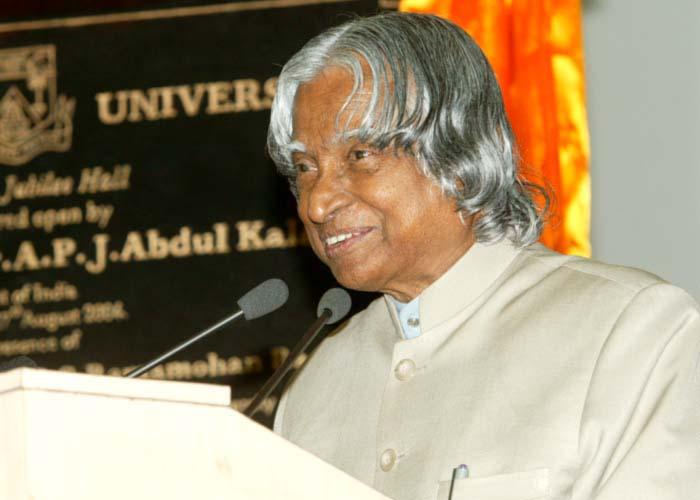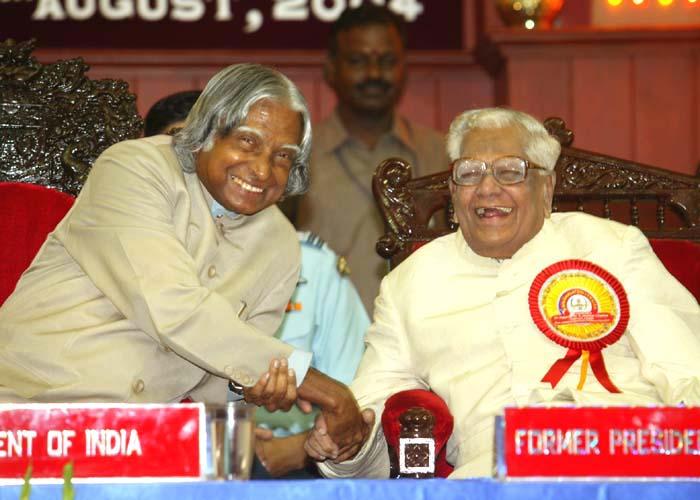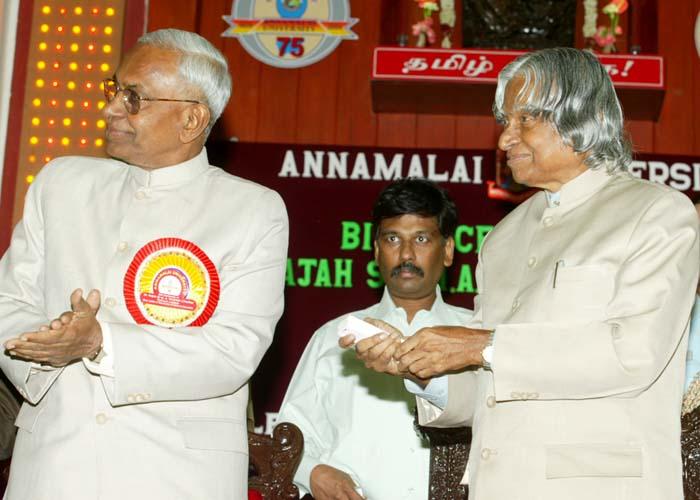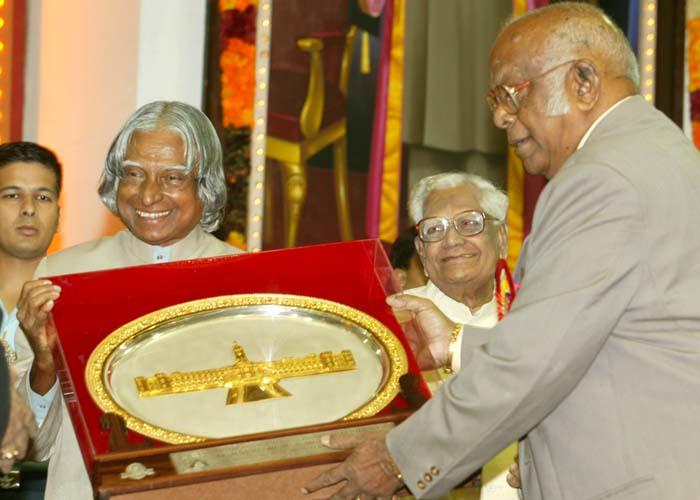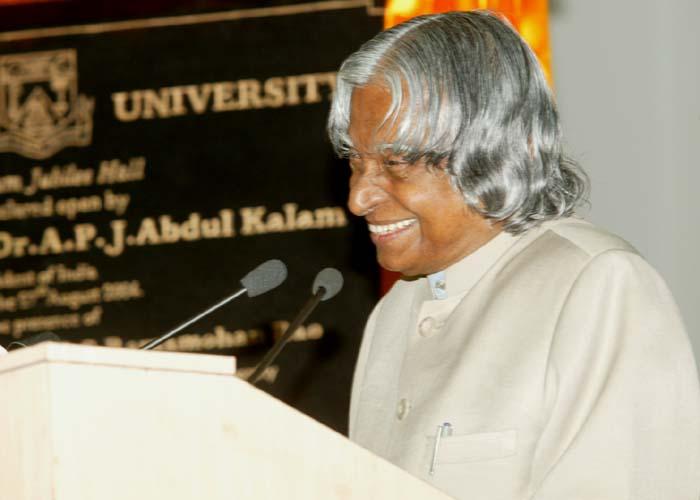Address During The Inauguration Of Jubilee Celebrations Of The Annamalai University
Annamalai Nagar : 27-08-2004
Pioneering Spirit: The learning Centre
I am delighted to participate in the Jubilee Celebrations of the Annamalai University. I am happy to note that today the Annamalai University is celebrating the birth centenary of Dr. Raja Sir M.A. Muthiah Chettiar, Platinum Jubilee of the University and Silver Jubilee of the Directorate of Distance Education. My greetings to the Chancellor, Pro-Chancellor, the Vice-Chancellor, faculty members, students and distinguished guests participating in this momentous function. Dr. Raja Sir M.A. Muthiah Chettiar was an ardent lover of Tamil had deep interest in education particularly technical education, a great parliamentarian and was a Tamil Isai Kavalar. His service in the cause of education included managing three primary schools, two high schools and two higher secondary school under auspices of Gandhi Nagar Education Society where over 11,000 children were studying. The major expansion of the Annamalai University took place during the pro-chancellorship of Muthiah Chettiar. When the faculty of education, finance, agriculture, law, medicine and the Directorate of Correspondence Courses were created. These courses have expanded considerably and nearly 3 lakhs students are benefiting from it. During this time two UGC advance centre of study in marine engineering and linguistics came into existence. His visionary action has made the University to grow into 48 departments of study with nearly 2,000 teaching staff and 5,000 administrative personnel and student strength of over 16,000. The National Assessment and Accreditation Council has accorded a four star status to the University. Being a residential university over 9,000 student stay in the hostel.
Distance Education Modernisation
I note that the core strength of the University is the distance education. With the information and technology tools available to the nation, I would recommend that the university may incorporate these tools in their distance education system for providing quality education to the remote students through Virtual Class rooms and for expansion of Distance Education for all parts of the world.
A multi-pronged approach for Tele-Education
A three-pronged approach is essential to make distance education programme viable and a successful proposition through the universal tele-education system to all parts of the country. The three components may be the Connectivity, Tele-Education delivery System and the Quality Content Generation by the experienced teachers and deployment of content.
Connectivity:
EDUSAT of ISRO, is expected to provide one-lakh fifty thousand ground terminals in its full capacity. The other parts of the country have to be covered by providing Broadband and Wireless communication network in an integrated fashion. Terrestrial optical communication is becoming cost effective and can complement the space communication with its low cost, high bandwidth and networking capability. An integrated networked system comprising EDUSAT, Broadband and Wireless networks should provide a highway for reaching quality education to all parts of the country. These connectivities can be made use of by Anamalai University for their out reach programme.
Tele-Education System:
Once we have the connectivity, then there should be a universal tele-education system in place for making full utilization of the connectivity to bring virtual classrooms in a multi class environment with seamless two-way interaction between the teachers and students in a collaborative environment. This system should not only enable the lecture delivered from the Studio at the university to reach any remote corner but also enable a good teacher in the remote area to provide multicast information to other participants of the programme.
A Tele-Education delivery system:
I would like to narrate our experience in tele-education piloted at Rashtrapati Bhavan for providing satellite connectivity for the PREVIK (President?s Virtual Institute for Knowledge) members. The connectivity is through V-SATs provided by ISRO, Voice Over-IP and Internet. In this platform, the live virtual studio environment is created and it will connect a number of remote locations and provides seamless, one to many connectivity, through multicasting mode in a collaborative environment. This also provides two-way connectivity. In this platform, I can give a presentation and address the remote locations, where the multimedia delivery is possible and also I can interact through various collaborative tools. I can refer any informational website from Internet to all the remote locations and can also delegate the remote expert to give a lecture to all those who are connected. We have also established the Digital Library and digitized around 2 million pages. I can search for a particular page and push the page to all the participants through this tele-education. It is an integrated solution, which makes me feel as if I am virtually connected to all participants in multiple locations. In the present context with respect to universities, EDUSAT provides the connectivity. An integrated Tele-education delivery mechanism is available and being used. What is required now is the generation of quality content for sharing and transmitting to remote students.
Quality Content Generation:
There are three components for education: lectures, laboratory and library. The content includes all the above three. Content can be generated in many ways. The first one is the assimilation of the subject by an expert teacher through research study of many books and articles leading to the generation of quality and creative content in a presentable format. The teacher presents in a unique and innovative way to make the content appealing and easily understandable to the students. The second form of content could be on a self-learning method by breaking down the content into a series of question answer models. Third may be from various books, which can be extracted through a digital library and presented just-in time to all the remote students. Fourth may be from Internet, where wealth of information is available. Teacher may search the information in the Internet and push the content live through the tele-education system.
The content should have supportive animations, which may even bring virtual laboratories and virtual immersion effects to the remote students. When the content is generated, it should be a sharable learning object across the nation and across all platforms. Some institutions and universities have already started developing their content. The content may be generated making use of the student?s creative and innovative thoughts under the guidance of the expert teachers as a group activity based on a pre-determined standard. This is possible where the capacity has been built by the educational institution into the student to teach while studying. The generated content through this process may be validated and deployed for delivery of lectures through tele-education system.
As an example, my lectures delivered during various functions are dynamically updated in our website. During the address many participants ask questions on several topics. The answers to these questions are also placed in the website as supplementary information. Similarly, the teachers after delivering the talk will also be asked a number of questions by the students. The proceedings of the questions & answers session can be added to the content document for enriching it.
Now I would like to discuss, how the universities could make use of the tele-education system for creating Virtual University with a typical model.
Virtual University
It is time that we should start looking at the possibility of creating a Virtual University in India through networking of all the universities and other educational institutions for imparting universal tele-education. Virtual university will have the following tasks:
a) Act as a central hub of all universities, which are networked.
b) Identify experts of national/international eminence in specialized areas and nominate institutions of eminence.
c) Coordinate, organize, schedule and broadcast the lecture of specialists at a mutually convenient time to all participants.
d) Record the live transmission of the lecture with interaction details in a data bank for easy access by participants for review learning.
e) Digitize all the university libraries and make it available for seamless access by all the universities.
f) The universities need to become learner centric.
This experiment across the country will provide a common platform for teaching in Schools, Colleges and Universities and even vocational courses. This will give equal emphasis on theory and experiments in spite of the fact that it will be done in the cyberspace. Such is the power of the technology and our understanding of it. This facility would also help in expansion of telecommunication and IT services. All this would lead to synergising the strengths of different universities in promoting quality education to our students in a cost effective manner. The other important aspects I would like to discuss is capacity building and employment generation during university education.
Employment Generation through entrepreneurship
There has been substantial growth in our higher educational system and we are generating over 3 million graduates every year. However our employment generation system is not in a position to absorb the graduates passing out from the universities leading to increase in educated unemployed, year after year. This situation will lead to instability in the social structure. We need higher education backed by employment opportunities. A multi pronged strategy is needed to make education more attractive and simultaneously create employment potential ? how do we do that?
Firstly, the educational system should highlight the importance of entrepreneurship and prepare the students right from the college education to get oriented towards setting up of the enterprises which will provide them creativity, freedom and ability to generate wealth. Apart from entrepreneurship, the youth should have the spirit that ?we can do it?. Secondly, the banking system should provide venture capital right from every village level to the prospective entrepreneurs for undertaking new enterprises. Banks have to be proactive to support the innovative products for enabling wealth generation by young entrepreneurs by setting aside the ?conventional tangible asset syndrome?. Definitely this involves certain amount of calculated risks, which can be eliminated by making an analysis of successful venture capital enterprises. Thirdly, there is a need to identify marketable products and enhancement of purchasing power among the people. This can come through the implementation of mega programmes such as PURA, Interlinking of Rivers, Infrastructural missions, Power missions and Tourism. Also genuine border trade can improve if we have a friendly border in all sectors.
The universities should become a facilitator for creating this entrepreneurship scheme through the support of the banking system and the marketing system. This is one way of reducing the employment gap leading to upliftment of the 260 million people living below the poverty line. I would like to discuss certain specific area where large scale employment generation is possible.
Alternative Sustainable Fuel
As you are aware, we have a concern about the long term availability of coal. I hear two types of estimates. One is that the reserves are available for over 100 years and the other talks about 30 to 40 years. Hence, there is a need to find an alternative fuel for our thermal power plants.
One of the promising alternatives is the production of bio-diesel through plants such as Jatropha. Chemical analysis indicates that bio-diesel can safely be used in gas turbines in combined cycle mode, as they are normally used for such capacities. Bio-diesel used in diesel engines has been well demonstrated, but diesel engines larger that 2.5 MW capacities are not commercially available now. A quick estimate of land requirements to meet the fuel needs of a 500 MW combined cycle power plant is 2.7 lakhs hectares. Since, we have large amount of waste land allotted for dry land cultivation amounting to 33 million hectares in the country this is not a problem area. The yield of bio-diesel is 1.70 tonnes/hectare. The bio-diesel requirements for a 500 MW are approximately 4.3 lakhs tonnes per annum operating at 70% plant load factor. The bio-diesel cost is estimated to be around Rs. 14.60 per liter (TERI Survey), which accounts for all the costs associated with plantation and seed collection, oil extraction and transesterfication. This will provide a long-term solution to the fuel problem on a sustainable basis and also generate large-scale employment opportunities for our rural population. Annamalai University can work on efficient methods of extraction of bio-diesel from various bio-diesel plants including Jatropha and also the agricultural department can carryout research in improving the quality of plants of bio-diesel seeds through hybridization process. I understand that the Tamil Nadu government has already planned certain initiatives for large-scale plantation for bio-diesel plants, but it has to be coupled with extraction of bio-diesel, national policy on use of bio-diesel utilization and generation of market avenues. Another area which can generate enterprises and employment opportunities to the students will be Providing Urban Amenities in Rural Areas (PURA) and the massive un-irrigated waste land in Tamil Nadu can become a wealth generator.
PURA
Providing Urban Amenities in Rural Areas (PURA) is essentially conceived around four types of connectivities, with the aim to speed up the process of achieving total rural prosperity. The first of these connectivities is Physical Connectivity for movement of people and goods, access to schools, health centres and markets. This can be provided through ring road, rail, public infrastructure and mobile clinic. The second of these connectivities is electronic connectivity, which will enable provision of internet, e-governance, tele-medicine and tele-education. The provision of electronic connectivity will lead to the creation of enlightened citizen with moral leadership through formal and informal education in schools, vocational centres and village panchayat libraries. The farmers can also acquire knowledge on land and crop management, water management, environmental management and forest management through knowledge connectivity. The establishment of physical, electronic and knowledge connectivity lead to the economic connectivity activity in the village such as agro-industries, markets, micro power points, warehouses leading to wealth generation. The PURA involves constitution of ten to thirty villages in a cluster with a population of around 30,000 to 50,000 people. It will involve creation of a business plan for providing employment to 3000 to 5000 persons by creating industries keeping the core competence of the village clusters in focus.
Annamalai University with their core-competence in agriculture, management, marine biology and bio-technology can establish in village areas around Manjakudi or any other area, a PURA enterprise with physical connectivity, electronic connectivity, knowledge connectivity leading to economic connectivity and employment generation covering about 20-30 villages having a population of fifty thousand. The students of the University can be trained to become entrepreneurs and provide the leadership for this PURA movement in this region.
Missions for the University
Annamalai University had the privilege of having Pro chancellors and Vice chancellors who were great Tamil scholars. Hence I thought of giving a mission.
Is it possible to recover the original of ?Thirukkural? wrote by the great Poet Saint Thiruvalluvar? It is the only work with 1330 kurals written 2000 years ago, does not have any reference to caste, religion, state or country. What a brilliant mind? We would like to know about this great personality. How to do that? A number of researchers from Annamalai University have to work and find out the mind of the Great saint poet Thiruvalluvar and raise the original palm leaf manuscript.
This university was started in an interior Tamilnadu as an integrated institution, it would be appropriate for the university to have rural development as a major mission, which will become an employment generator for the rural youth of Tamilnadu. As a part of these missions, the university can work on establishing water bodies, which is an essential need for this region. This could be the second mission for the University.
Conclusion
What can be the best teaching in such an experienced University like Annamalai University. Every one of us has gone through the various phases of education from childhood to profession. A scene appears in front of me. A child, a teenager, an adult and a leader. How does each one react to a particular situation? The situation is human need. The child asks, "What can you do for me"? The teenager says, "I want to do it alone". The young person proclaims, "let us do it together". The leader offers, "What can I do for you". So, the faculty members of Annamalai University have got a tremendous responsibility to transform the students into leaders - the transformation of 'what can you do for me' to 'what can I do for you'. That will demand faculty members to be with inspiring leadership quality. I am sure; the best of creativity among the students will emerge by integrated influence of Vice-Chancellor, principals and faculty members on students.
My greetings to all the members of Annamalai University community during this Triune celebration and best wishes for success in all your future missions.
May God bless you.

